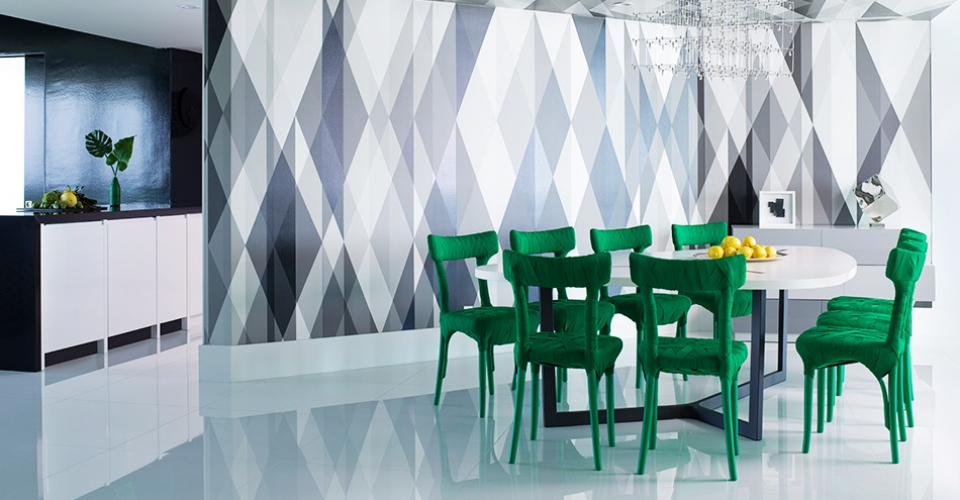
February 2, 2015New York interior designer Christopher Coleman specializes in brightly colored spaces punctuated by graphic patterns and a playfully mod sensibility (photo by Stephan Julliard). Top: For an apartment in Miami, the designer paired a custom sofa with Serge Mouille floor lamps and wall art he made using auto lacquer on wood. All photos by Ken Hayden unless otherwise noted
If you had been strolling home in New York during the early 1990s, in the wee hours after a night on the town, you might have seen a handsome, lanky young man with a shock of red hair emerge from a dumpster in front of a construction site, a discarded piece of furniture in one hand and a triumphant smile on his face. That would have been designer Christopher Coleman, who, though already a rising design star, was indulging his fascination with the possibilities inherent in what others discard. The old aphorism “One man’s trash is another man’s treasure” has rarely felt more apt than in the case of Coleman, who, despite the fact that he now spends more time overseeing high-profile projects in places like Paris and Miami than he does poking around dumpsters, still values the unique, quirky find over the high-priced name-brand item.
Back when he was establishing himself in New York, the 52-year-old designer says he spent every weekend at the flea market on 26th Street. “That’s where I met the likes of Liz O’Brien, Evan Lobel [of Lobel Modern] and R & Company‘s Evan Snyderman and Zesty Meyers. I grew up with these people,” he says, referring to folks who are now some of the city’s leading furniture dealers but, like Coleman, started off hip, young, alternative and scrappily industrious.
There are other designers, of course, who ply this high-low brand of inventiveness nowadays. But few do it with the panache necessary to sidestep a certain flea-market quirkiness, which can feel more quaint than cool. Still fewer realize that their contemporary, industrial-chic version of “mod” owes a debt — at least in part — to an aesthetic Coleman perfected two decades ago. Classic modern silhouettes reimagined with eye-popping patterns? Check. Bold use of bright primary colors, often against stark black and white? Check. Strong geometries on fabrics and rugs? A predilection for stripes, grids and diagonals? Clear, crisp lines that telegraph graphic purity? Check. Check. Check.

For a South American family’s New York pied-à-terre in a new high-rise on the Upper West Side, Coleman opted for a palette of white with blue accents, a clean, sleek look that showcases the family’s collection of Latin American art.
Coleman grew up as one of seven in what he calls a “big, lower-middle-class Catholic family” in the Baltimore suburb of Lutherville-Timonium, Maryland. “We had bunk beds in every room,” he says. He tagged along with his mother to museums and show houses and gave the room he shared with a brother a distinctive flair: pale gray walls (except for one of corkboard), a “fantastic” hanging chair and a purple carpet.
After studying graphic and interior design at the Maryland Institute of Art and later, York Academy, in Pennsylvania, Coleman moved to New York, where he says he “took my big old-fashioned portfolio and hit the streets.” He spent a year as a draftsman and assistant designer at interior design firm Lloyd Bell Associates, waiting on tables at night to help pay the rent, and the next five at Macy’s where he oversaw colors and materials on the corporate store-design team, which also included designers S. Russell Groves and the late Randy Ridless. That, he says, is where “I learned about vendors and how to be organized on huge projects.”
In 1991, he moved on to the office of modernist Renny Saltzman, where for four years he worked on residences for such high-profile clients as Candice Bergen, Joel Grey and art dealer Arne Glimcher. “We used a lot of Dakota Jackson and Ron Seff,” Coleman recalls. Feeling restless, Coleman next started CCCM Interiors in 1995 with Carlos Mota, now the international style editor of Architectural Digest.

A chandelier by Lindsey Adelman hangs over the dining table in a Manhattan home belonging to art-collecting clients. The chairs are covered in Jab Anstoetz Fabrics and the braided-metal rug is by Tai Ping.
Early on, the duo was accepted to the prestigious Southampton Show House — but they had no money. “We went to thrift shops, took legs off tables and made Lucite bases, jumped in dumpsters, put things on credit cards and worked with emerging artists,” remembers Coleman. “Carlos was very creative. He covered walls in chalkboard, used eighteenth-century chairs with Kuba cloth, taught me about pattern. We were taking things apart and putting unlikely things together.”
That child’s room they created for the show house, and the attendant press it received, led to “a lot of kids rooms for a while,” Coleman recalls, as well as a line of children’s furniture. But other projects expanded their repertoire: the apartments of Sotheby’s auctioneer Robert Woolley, high-powered Manhattan real estate broker Robby Browne, a consultation with the model Tyra Banks. Mota went his own way shortly after, and Coleman regrouped as Christopher Coleman Interior Design.
Since then, Coleman’s clients have included fashion journalist Kate Betts (then the editor in chief of Harper’s Bazaar); former Time Inc. chairman Don Logan; and Helen Henson, the widow of Muppets creator Jim Henson. Today, the people who generally commission Coleman are in their 30s, 40s or 50s, and his roster includes a large sampling from South America. This can be attributed to Coleman’s 14-year relationship with Venezuelan-born architect-turned-fashion designer Angel Sanchez, with whom Coleman collaborates on projects and also shares homes in Brooklyn, Miami and Hudson, New York. Many of their clients are young families, says Coleman. “We’re kid-friendly. We’re not doing rooms you can’t play in or that don’t have a sense of fun.”
“We’re kid-friendly. We’re not doing rooms you can’t play in or that don’t have a sense of fun.”

Coleman custom-designed a white lacquer bunk bed for a girls’ bedroom on Manhattan’s East Side. Photo by Peter Murdock
Whether intended for children or not, all of Coleman’s rooms show a predilection for vibrant color, bold silhouettes and a certain graphic quality, with lots of black outlines that the designer traces to his early studies in design and typography. Few, if any, of his clients are buying Koons, Warhol and their ilk. “The top ten names don’t interest me,” says Coleman. “I want to work with young artists who will become players.” Among those currently on his radar are Thomas Burke, Edie Nadelhaft, Patrick Lundeen and Zin Helena Song.
This emphasis on the latest art and innovations — whether paper constructions by Jane Creech or collages by Paulo Castro, drapery made of fine Neoprene snipped from Sanchez’s latest fashion line or Brazilian quartz slabs injected with super-saturated colors — is what keeps Coleman’s work fresh and vital. “I’m always interested in new materials and vendors,” he explains. Which is one reason he opened the Christopher Coleman Collection this year, a design store on Warren Street in Hudson.
Coleman just finished a five-bedroom duplex in Paris’s Seventh Arrondissement for one of his earliest and most faithful clients. Currently, he is at work on three Miami apartments, Sanchez’s Miami boutique (scheduled to open in Spring 2016) and a 10,000-square-foot house in Key Biscayne for the hotelier behind the chic new Vintro South Beach. Stylistically, he says, he is moving into “a lot of saturated color, where the sofa, wall and floor are all the same,” and he is using color and pattern in a “cleaned-up, more refined way that’s less busy.”
Of course, even as his style evolves, some old habits die hard. “It’s amazing what you still find in the trash,” he says.

























